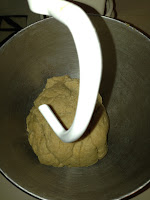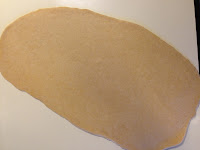Yield: 3 baguettes
700 calories per baguette
Active time: 25 minutes
Total time: Up to 20 hours
ingredients
for the starter
1/2 cup lukewarm water
A pinch of yeast
1 cup high gluten
flour
for the dough
1 teaspoon yeast
1 cup lukewarm water
all of the starter
3 ½ cups high gluten flour
2
teaspoons salt
preparation
the day before:
1. In a small sized bowl or Tupperware, combine the lukewarm water, yeast, and
flour. Stir, cover, and let rest at room temperature for about 14 hours, or
overnight.
the day of:
2. Take out
starter, it should have risen and become bubbly. If it hasn't,
your yeast may not be working. Dissolve 1/4 teaspoon of yeast in 1 tablespoon
lukewarm water with a pinch of sugara Add to your starter and wait 15 minutes. If nothing happens,
replace your yeast, and begin the starter process again.
Because I used a starter I began cultivating
over 5 days ago, my starter didn't look super active. I dissolved pinches of yeast
and sugar along with a tablespoon of lukewarm water to get it going.
4. In your
stand mixer bowl, combine the flour, salt, and all of the starter. (I used 1 ½ cup of my rye starter.)
5. Using the dough hook attachment, “stir”
until a shaggy dough forms.
6. Slowly pour in the yeast mixture, kneading
on “stir” until a cohesive dough forms.
7. Increase your stand mixer speed to 2 or 3 and
knead until a smooth and elastic dough forms, about 5 minutes.
8. Turn the dough out onto a counter top and
knead by hands a few turns, forming a ball.
9. Place the ball into a large bowl, lightly
oiled bowl, cover with plastic wrap, and set aside.
11. After another hour has elapsed (120 minutes after first set the dough aside to rise), punch down the dough, re-cover with plastic wrap, and set-aside.
12. After another hour has elapsed (three hours
since you first set the dough aside in step 9), turn the dough out onto your counter top
and divide into three pieces.
14. Fold each rope in half, squeezing to
release air bubbles, and shaping
into a baguette by gently rolling on the counter top to stretch the log
accordingly. You want to be sure to knead out the air bubbles, or the result will be a humongous, lopsided loaf. Sadly, this was a lesson learnt through experience.)
15. Place on a parchment or silpat lined baking sheet, or baguette pan. Repeat with the remaining pieces of dough.
16. Cover with plastic wrap and let rise until very puffy, about
90 minutes.
17. I also made stuffed baguettes with one portion of the dough by cutting the dough into four pieces, rolling each piece out, filling each with smoked gouda and bacon and forming a jelly roll. (See “loaded baked potato pinwheels” for more cooking bacon and forming pinwheels.) I gave the stuffed baguettes about 30 minutes to rise.
18. With about 30 minutes remaining in the final proof, preheat your oven to 450 degrees.
17. I also made stuffed baguettes with one portion of the dough by cutting the dough into four pieces, rolling each piece out, filling each with smoked gouda and bacon and forming a jelly roll. (See “loaded baked potato pinwheels” for more cooking bacon and forming pinwheels.) I gave the stuffed baguettes about 30 minutes to rise.
18. With about 30 minutes remaining in the final proof, preheat your oven to 450 degrees.
19. Cover the baguettes with an egg wash and score.
20. Arrange a water bath and bake for 20-25 minutes, until the baguettes are golden brown and sound hollow when tapped. (See step 9 of “carbs, glorious carbs!” for more on water baths.)
Original recipe found here.
20. Arrange a water bath and bake for 20-25 minutes, until the baguettes are golden brown and sound hollow when tapped. (See step 9 of “carbs, glorious carbs!” for more on water baths.)










































































